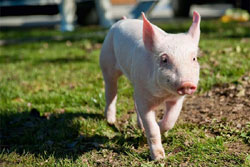



Mastitis and Endotoxins in Sows: What are the Consequences for Colostrum?
It is widely accepted that endotoxins play a role in Mastitis Metritis Agalactia (MMA) complex, according to Dr Simone Schaumberger of Biomin Holding GmbH.
Endotoxins are parts of the cell wall of Gram-negative bacteria (e.g. E. coli, Salmonella). They act as pyrogens (induce fever) and have a potent immunomodulatory effect. If the animal is healthy, gut-derived endotoxins are transported via the portal vein to the liver and are eliminated there.
An overwhelming release of endotoxins activates further cascades, which in the worst cases may lead to an endotoxic shock and even death.
Endotoxins are also called lipopolysaccharides (LPS) and are released by bacteria after death or during proliferation. Administration of special kinds of antibiotics (e.g. Beta-lactam) can increase the liberation of endotoxins because of their bactericidal activity. This fact should be taken into consideration when treating Mastitis Metritis Agalactia (MMA) complex and the additional use of NSAID (non-steroidal anti-inflammatory drug) is recommended.
Mastitis Metritis Agalactia (MMA) complex is a multi-factorial disease. In general, there is no single specific cause. The interaction of several factors leads to a disease outbreak.
 |
Kemper (2007) listed factors such as water intake, feeding regime, lack of exercise and farm management. She also mentioned three disposing aspects which support the occurrence of MMA: colonic inertia, urinary tract infections and prolonged birth. It has also been pointed out that endotoxins may worsen the problem. Waldmann (2000) went a step further, proposing that endotoxins are disease triggers for uterine infections and mastitis.
Consequently, endotoxins seem to play a significant role in the MMA complex, although not in the initial stage of the disease. Due to stress, re-housing and lack of exercise, intestinal activity is reduced. This is followed by obstipation, which is the point when endotoxins may start to cause problems. The load of endotoxin exposure in the near-birth period depends on the blockages as mentioned and fat loss, which may happen at this time.
At first, endotoxins lead to a deterioration of the general condition of the sow. Thereafter fever or circulatory disorders may result from endotoxins circulating in the blood. There are several explanations for an increase in endotoxins in the blood of the animals. Kruger et al (2000) and Kamphues (2000) stated that the feeding regime before and after birth has the greatest impact on the MMA complex. Special attention should be paid to the sow during this period.
Further, it has been shown that endotoxins suppress the production of prolactin (hormone for milk production), which leads to a depletion of milk. Endotoxin contamination of the sow colostrum may have a negative impact on piglets and result in diarrhea.
To test the incidence of endotoxins in the sow colostrum, 102 colostrum samples from 42 sows were tested for their endotoxin activity (Biomin Research Center, 2013). Samples were taken at three, six and 24 hours after birth. It was shown that endotoxins were excreted via the colostrum and milk of sows.
 |
Another study by Ratzinger (2010) showed the difference in the endotoxin values in the milk of healthy and treated sows due to MMA. Average endotoxin values were higher compared to the colostrum study and differences between treated and non-treated sows were observed. The highest deviation between the healthy and treated sows was seen in week 2 after farrowing.
It is widely accepted that endotoxins play a role in the MMA complex. Studies have shown the presence of endotoxins in colostrum and milk but the direct effects of contaminated milk on piglets have to be further investigated. As endotoxins cannot be avoided in the environment of pigs, controlling their proliferation to prevent MMA disease in sows is essential, and recommended.
July 2014








